BSBMGT516 Project: Continuous Improvement Processes Implementation
VerifiedAdded on 2022/11/25
|10
|1994
|105
Project
AI Summary
This project, submitted by a student and available on Desklib, examines continuous improvement processes within a business context, specifically focusing on the implementation of Customer Relationship Management (CRM) and Point of Sale (POS) systems. The project outlines the steps required for rolling out both systems, including needs identification, goal definition, document gathering, vendor selection, and employee training. It details the benefits of each system, such as improved customer relationships, increased sales, payment efficiency, and data accuracy. The project also explores methods for mentoring and coaching team members through training and testing. Furthermore, it addresses the importance of employee understanding, monitoring implementation progress, gathering customer feedback, and adhering to continuous improvement principles. It also analyzes both external (customer pressure, ownership changes, competitive advantage) and internal forces (financial, physical, human resources, intellectual property) that impact organizational change. The project emphasizes the role of positive employee attitudes and the need for reviewing and adapting to disruptive changes, ensuring that all changes benefit the organization and improve work processes.
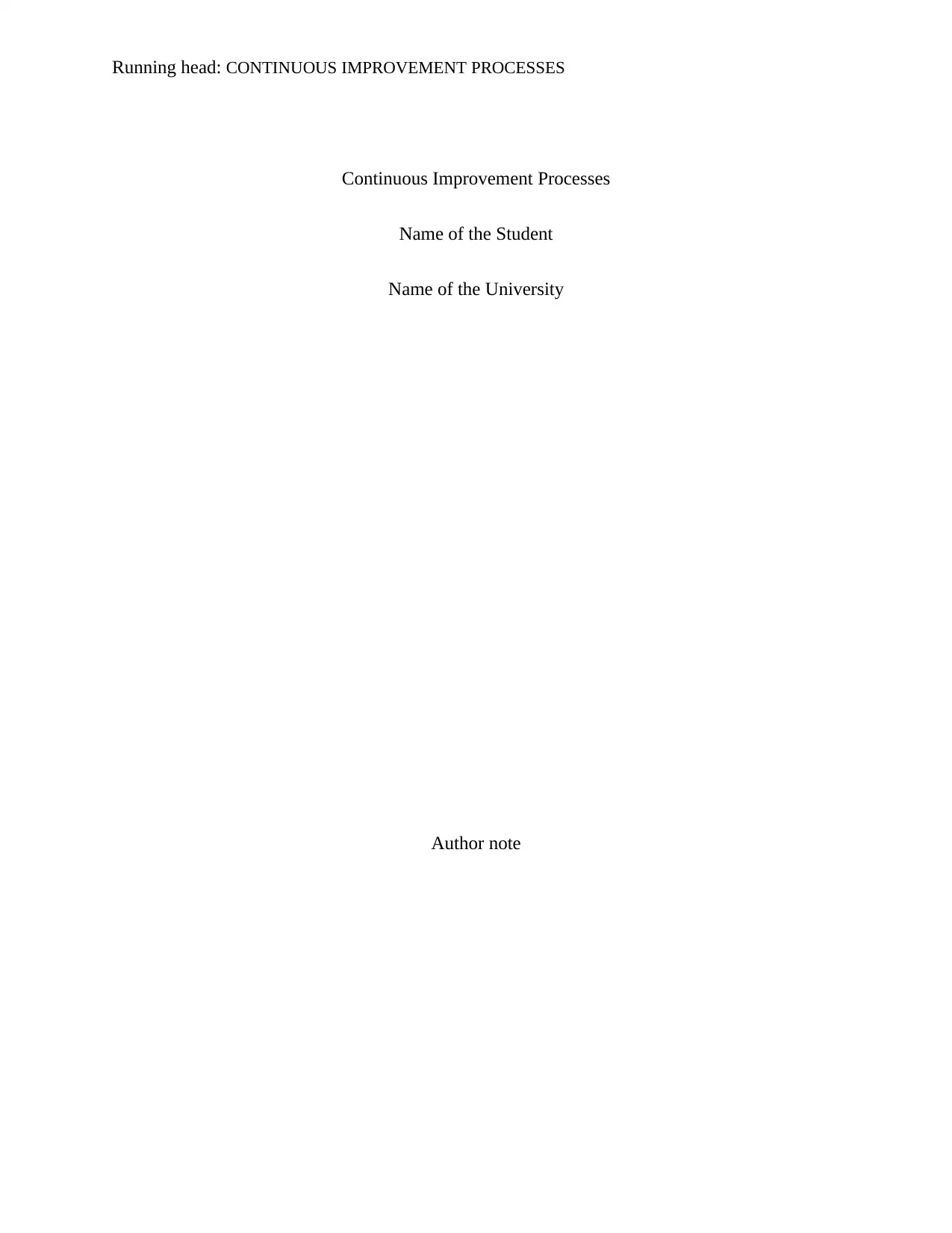
Running head: CONTINUOUS IMPROVEMENT PROCESSES
Continuous Improvement Processes
Name of the Student
Name of the University
Author note
Continuous Improvement Processes
Name of the Student
Name of the University
Author note
Paraphrase This Document
Need a fresh take? Get an instant paraphrase of this document with our AI Paraphraser
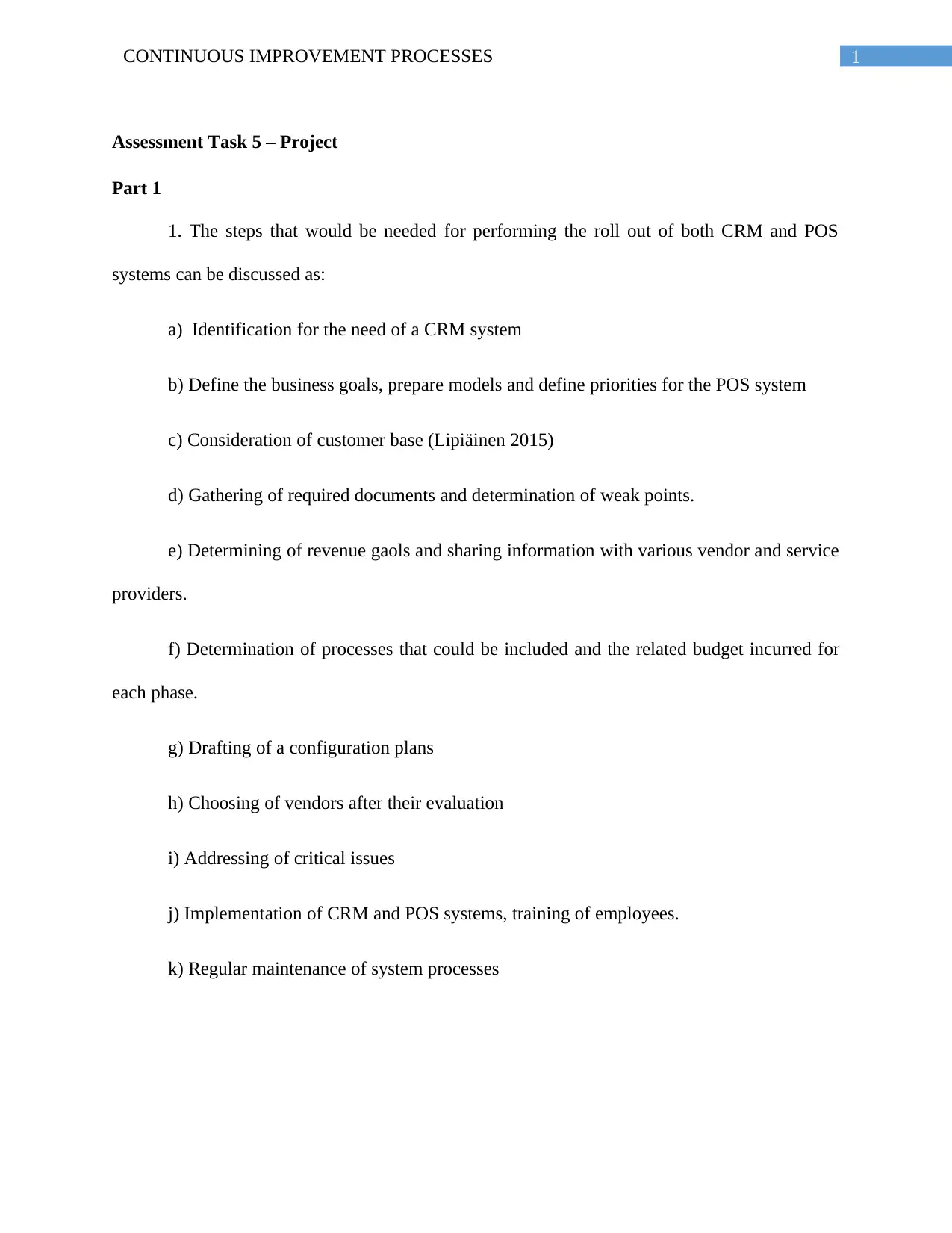
1CONTINUOUS IMPROVEMENT PROCESSES
Assessment Task 5 – Project
Part 1
1. The steps that would be needed for performing the roll out of both CRM and POS
systems can be discussed as:
a) Identification for the need of a CRM system
b) Define the business goals, prepare models and define priorities for the POS system
c) Consideration of customer base (Lipiäinen 2015)
d) Gathering of required documents and determination of weak points.
e) Determining of revenue gaols and sharing information with various vendor and service
providers.
f) Determination of processes that could be included and the related budget incurred for
each phase.
g) Drafting of a configuration plans
h) Choosing of vendors after their evaluation
i) Addressing of critical issues
j) Implementation of CRM and POS systems, training of employees.
k) Regular maintenance of system processes
Assessment Task 5 – Project
Part 1
1. The steps that would be needed for performing the roll out of both CRM and POS
systems can be discussed as:
a) Identification for the need of a CRM system
b) Define the business goals, prepare models and define priorities for the POS system
c) Consideration of customer base (Lipiäinen 2015)
d) Gathering of required documents and determination of weak points.
e) Determining of revenue gaols and sharing information with various vendor and service
providers.
f) Determination of processes that could be included and the related budget incurred for
each phase.
g) Drafting of a configuration plans
h) Choosing of vendors after their evaluation
i) Addressing of critical issues
j) Implementation of CRM and POS systems, training of employees.
k) Regular maintenance of system processes
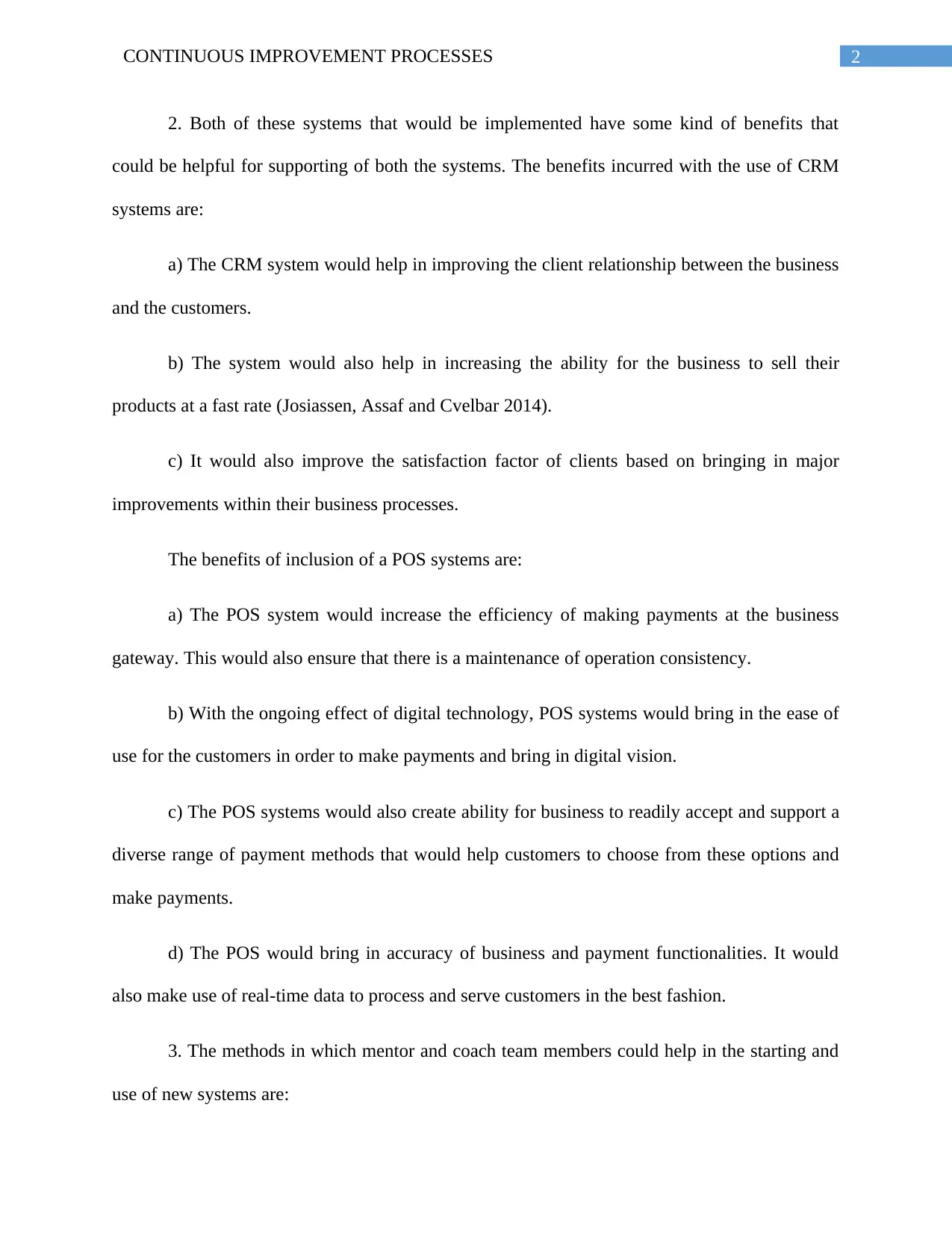
2CONTINUOUS IMPROVEMENT PROCESSES
2. Both of these systems that would be implemented have some kind of benefits that
could be helpful for supporting of both the systems. The benefits incurred with the use of CRM
systems are:
a) The CRM system would help in improving the client relationship between the business
and the customers.
b) The system would also help in increasing the ability for the business to sell their
products at a fast rate (Josiassen, Assaf and Cvelbar 2014).
c) It would also improve the satisfaction factor of clients based on bringing in major
improvements within their business processes.
The benefits of inclusion of a POS systems are:
a) The POS system would increase the efficiency of making payments at the business
gateway. This would also ensure that there is a maintenance of operation consistency.
b) With the ongoing effect of digital technology, POS systems would bring in the ease of
use for the customers in order to make payments and bring in digital vision.
c) The POS systems would also create ability for business to readily accept and support a
diverse range of payment methods that would help customers to choose from these options and
make payments.
d) The POS would bring in accuracy of business and payment functionalities. It would
also make use of real-time data to process and serve customers in the best fashion.
3. The methods in which mentor and coach team members could help in the starting and
use of new systems are:
2. Both of these systems that would be implemented have some kind of benefits that
could be helpful for supporting of both the systems. The benefits incurred with the use of CRM
systems are:
a) The CRM system would help in improving the client relationship between the business
and the customers.
b) The system would also help in increasing the ability for the business to sell their
products at a fast rate (Josiassen, Assaf and Cvelbar 2014).
c) It would also improve the satisfaction factor of clients based on bringing in major
improvements within their business processes.
The benefits of inclusion of a POS systems are:
a) The POS system would increase the efficiency of making payments at the business
gateway. This would also ensure that there is a maintenance of operation consistency.
b) With the ongoing effect of digital technology, POS systems would bring in the ease of
use for the customers in order to make payments and bring in digital vision.
c) The POS systems would also create ability for business to readily accept and support a
diverse range of payment methods that would help customers to choose from these options and
make payments.
d) The POS would bring in accuracy of business and payment functionalities. It would
also make use of real-time data to process and serve customers in the best fashion.
3. The methods in which mentor and coach team members could help in the starting and
use of new systems are:
⊘ This is a preview!⊘
Do you want full access?
Subscribe today to unlock all pages.

Trusted by 1+ million students worldwide
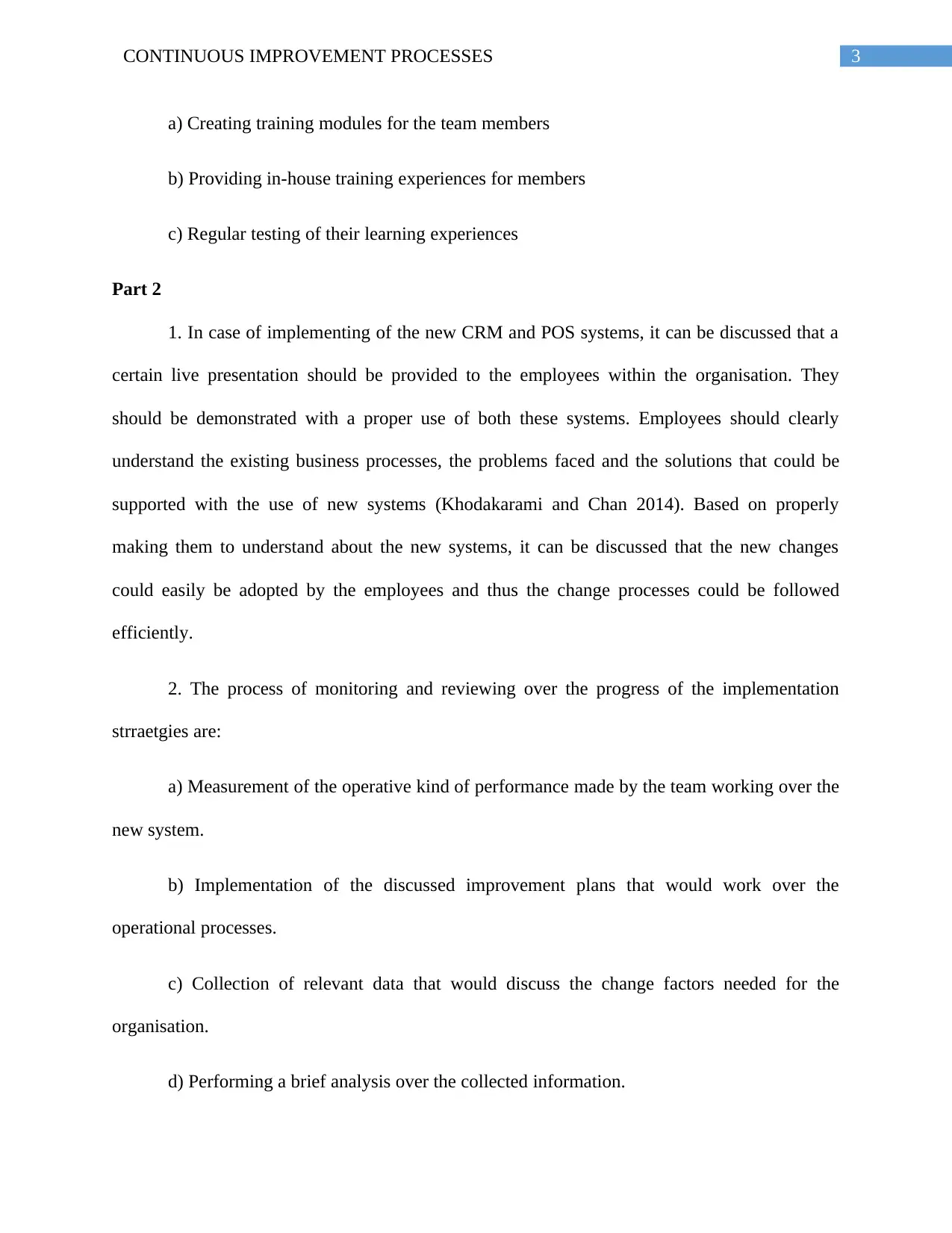
3CONTINUOUS IMPROVEMENT PROCESSES
a) Creating training modules for the team members
b) Providing in-house training experiences for members
c) Regular testing of their learning experiences
Part 2
1. In case of implementing of the new CRM and POS systems, it can be discussed that a
certain live presentation should be provided to the employees within the organisation. They
should be demonstrated with a proper use of both these systems. Employees should clearly
understand the existing business processes, the problems faced and the solutions that could be
supported with the use of new systems (Khodakarami and Chan 2014). Based on properly
making them to understand about the new systems, it can be discussed that the new changes
could easily be adopted by the employees and thus the change processes could be followed
efficiently.
2. The process of monitoring and reviewing over the progress of the implementation
strraetgies are:
a) Measurement of the operative kind of performance made by the team working over the
new system.
b) Implementation of the discussed improvement plans that would work over the
operational processes.
c) Collection of relevant data that would discuss the change factors needed for the
organisation.
d) Performing a brief analysis over the collected information.
a) Creating training modules for the team members
b) Providing in-house training experiences for members
c) Regular testing of their learning experiences
Part 2
1. In case of implementing of the new CRM and POS systems, it can be discussed that a
certain live presentation should be provided to the employees within the organisation. They
should be demonstrated with a proper use of both these systems. Employees should clearly
understand the existing business processes, the problems faced and the solutions that could be
supported with the use of new systems (Khodakarami and Chan 2014). Based on properly
making them to understand about the new systems, it can be discussed that the new changes
could easily be adopted by the employees and thus the change processes could be followed
efficiently.
2. The process of monitoring and reviewing over the progress of the implementation
strraetgies are:
a) Measurement of the operative kind of performance made by the team working over the
new system.
b) Implementation of the discussed improvement plans that would work over the
operational processes.
c) Collection of relevant data that would discuss the change factors needed for the
organisation.
d) Performing a brief analysis over the collected information.
Paraphrase This Document
Need a fresh take? Get an instant paraphrase of this document with our AI Paraphraser
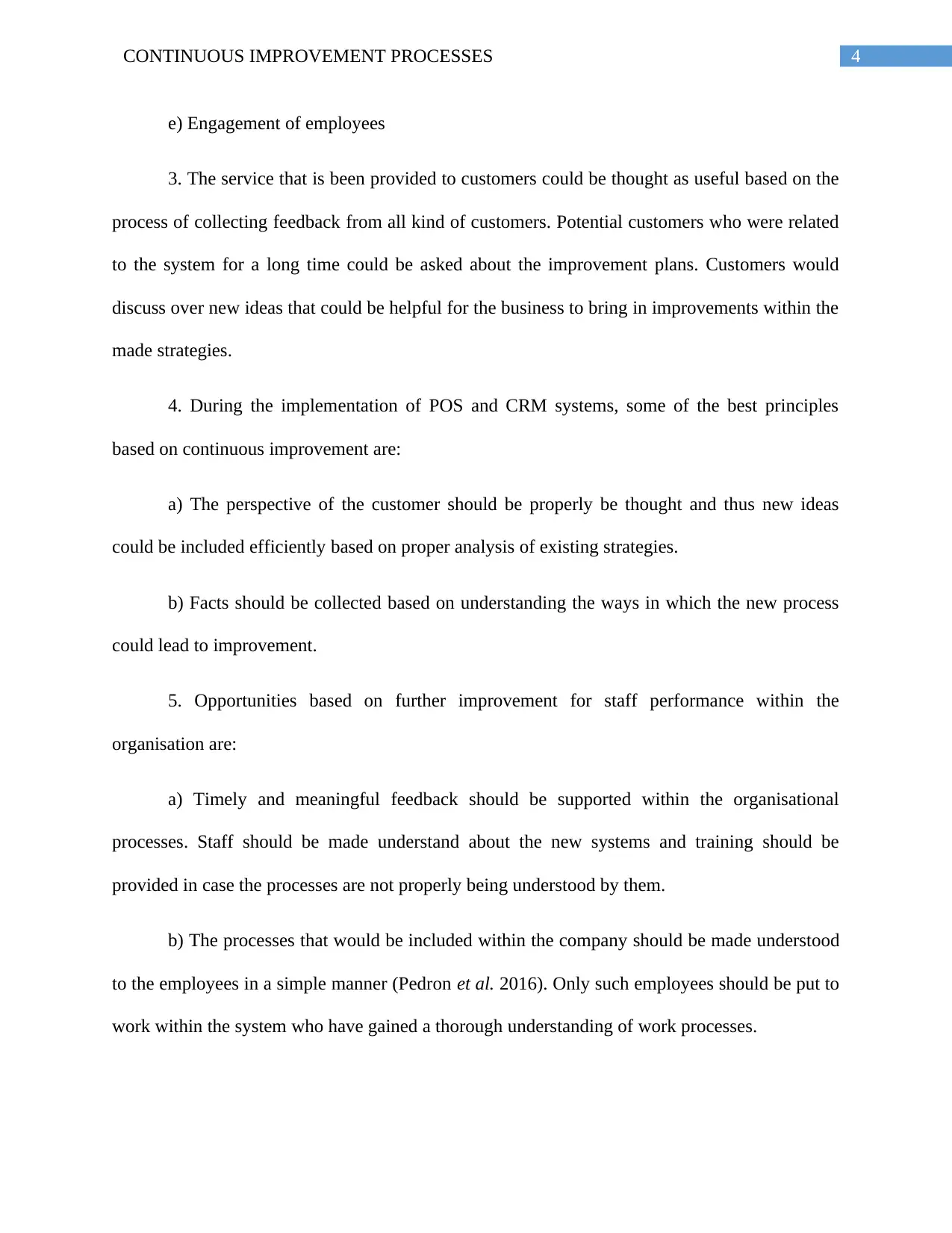
4CONTINUOUS IMPROVEMENT PROCESSES
e) Engagement of employees
3. The service that is been provided to customers could be thought as useful based on the
process of collecting feedback from all kind of customers. Potential customers who were related
to the system for a long time could be asked about the improvement plans. Customers would
discuss over new ideas that could be helpful for the business to bring in improvements within the
made strategies.
4. During the implementation of POS and CRM systems, some of the best principles
based on continuous improvement are:
a) The perspective of the customer should be properly be thought and thus new ideas
could be included efficiently based on proper analysis of existing strategies.
b) Facts should be collected based on understanding the ways in which the new process
could lead to improvement.
5. Opportunities based on further improvement for staff performance within the
organisation are:
a) Timely and meaningful feedback should be supported within the organisational
processes. Staff should be made understand about the new systems and training should be
provided in case the processes are not properly being understood by them.
b) The processes that would be included within the company should be made understood
to the employees in a simple manner (Pedron et al. 2016). Only such employees should be put to
work within the system who have gained a thorough understanding of work processes.
e) Engagement of employees
3. The service that is been provided to customers could be thought as useful based on the
process of collecting feedback from all kind of customers. Potential customers who were related
to the system for a long time could be asked about the improvement plans. Customers would
discuss over new ideas that could be helpful for the business to bring in improvements within the
made strategies.
4. During the implementation of POS and CRM systems, some of the best principles
based on continuous improvement are:
a) The perspective of the customer should be properly be thought and thus new ideas
could be included efficiently based on proper analysis of existing strategies.
b) Facts should be collected based on understanding the ways in which the new process
could lead to improvement.
5. Opportunities based on further improvement for staff performance within the
organisation are:
a) Timely and meaningful feedback should be supported within the organisational
processes. Staff should be made understand about the new systems and training should be
provided in case the processes are not properly being understood by them.
b) The processes that would be included within the company should be made understood
to the employees in a simple manner (Pedron et al. 2016). Only such employees should be put to
work within the system who have gained a thorough understanding of work processes.
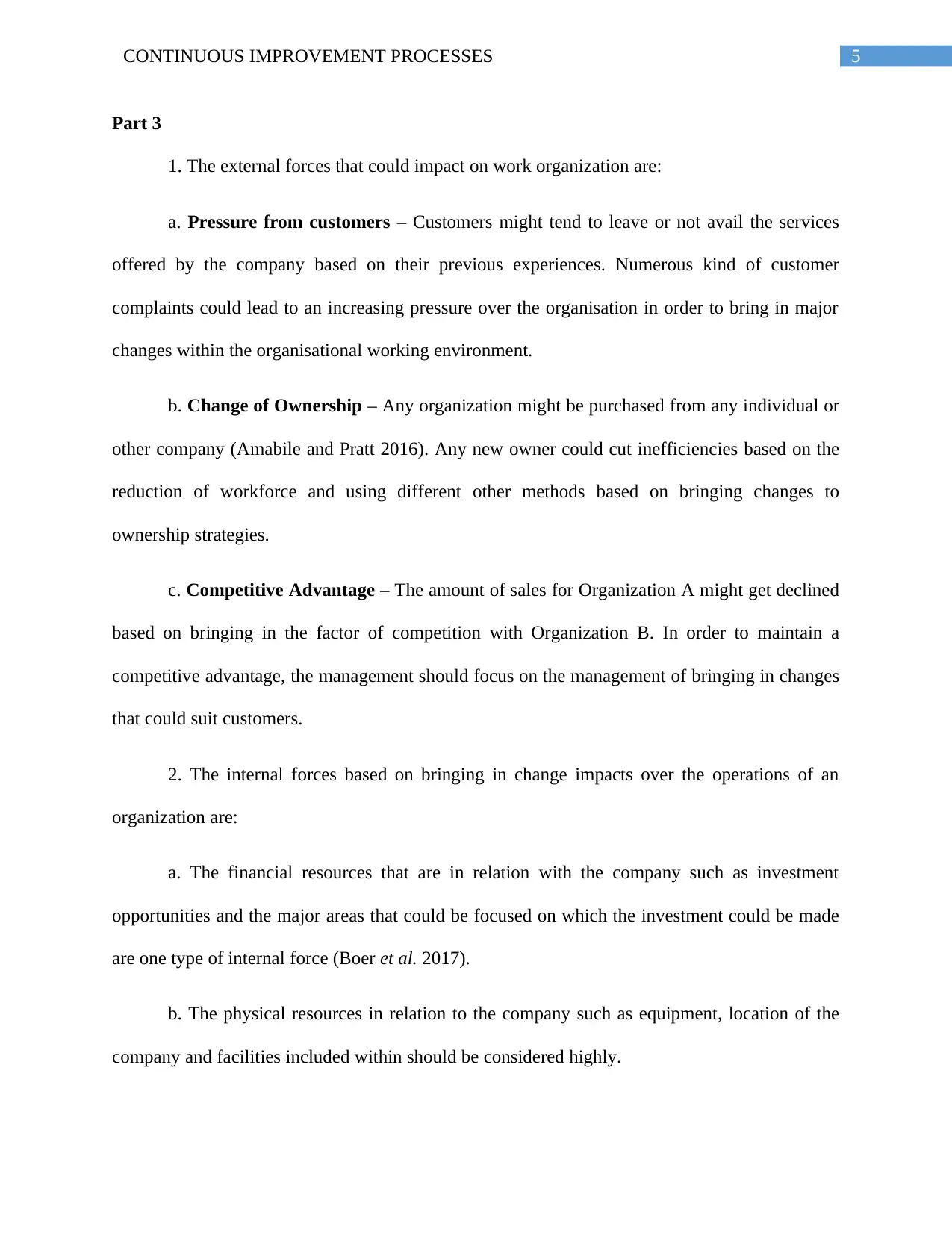
5CONTINUOUS IMPROVEMENT PROCESSES
Part 3
1. The external forces that could impact on work organization are:
a. Pressure from customers – Customers might tend to leave or not avail the services
offered by the company based on their previous experiences. Numerous kind of customer
complaints could lead to an increasing pressure over the organisation in order to bring in major
changes within the organisational working environment.
b. Change of Ownership – Any organization might be purchased from any individual or
other company (Amabile and Pratt 2016). Any new owner could cut inefficiencies based on the
reduction of workforce and using different other methods based on bringing changes to
ownership strategies.
c. Competitive Advantage – The amount of sales for Organization A might get declined
based on bringing in the factor of competition with Organization B. In order to maintain a
competitive advantage, the management should focus on the management of bringing in changes
that could suit customers.
2. The internal forces based on bringing in change impacts over the operations of an
organization are:
a. The financial resources that are in relation with the company such as investment
opportunities and the major areas that could be focused on which the investment could be made
are one type of internal force (Boer et al. 2017).
b. The physical resources in relation to the company such as equipment, location of the
company and facilities included within should be considered highly.
Part 3
1. The external forces that could impact on work organization are:
a. Pressure from customers – Customers might tend to leave or not avail the services
offered by the company based on their previous experiences. Numerous kind of customer
complaints could lead to an increasing pressure over the organisation in order to bring in major
changes within the organisational working environment.
b. Change of Ownership – Any organization might be purchased from any individual or
other company (Amabile and Pratt 2016). Any new owner could cut inefficiencies based on the
reduction of workforce and using different other methods based on bringing changes to
ownership strategies.
c. Competitive Advantage – The amount of sales for Organization A might get declined
based on bringing in the factor of competition with Organization B. In order to maintain a
competitive advantage, the management should focus on the management of bringing in changes
that could suit customers.
2. The internal forces based on bringing in change impacts over the operations of an
organization are:
a. The financial resources that are in relation with the company such as investment
opportunities and the major areas that could be focused on which the investment could be made
are one type of internal force (Boer et al. 2017).
b. The physical resources in relation to the company such as equipment, location of the
company and facilities included within should be considered highly.
⊘ This is a preview!⊘
Do you want full access?
Subscribe today to unlock all pages.

Trusted by 1+ million students worldwide
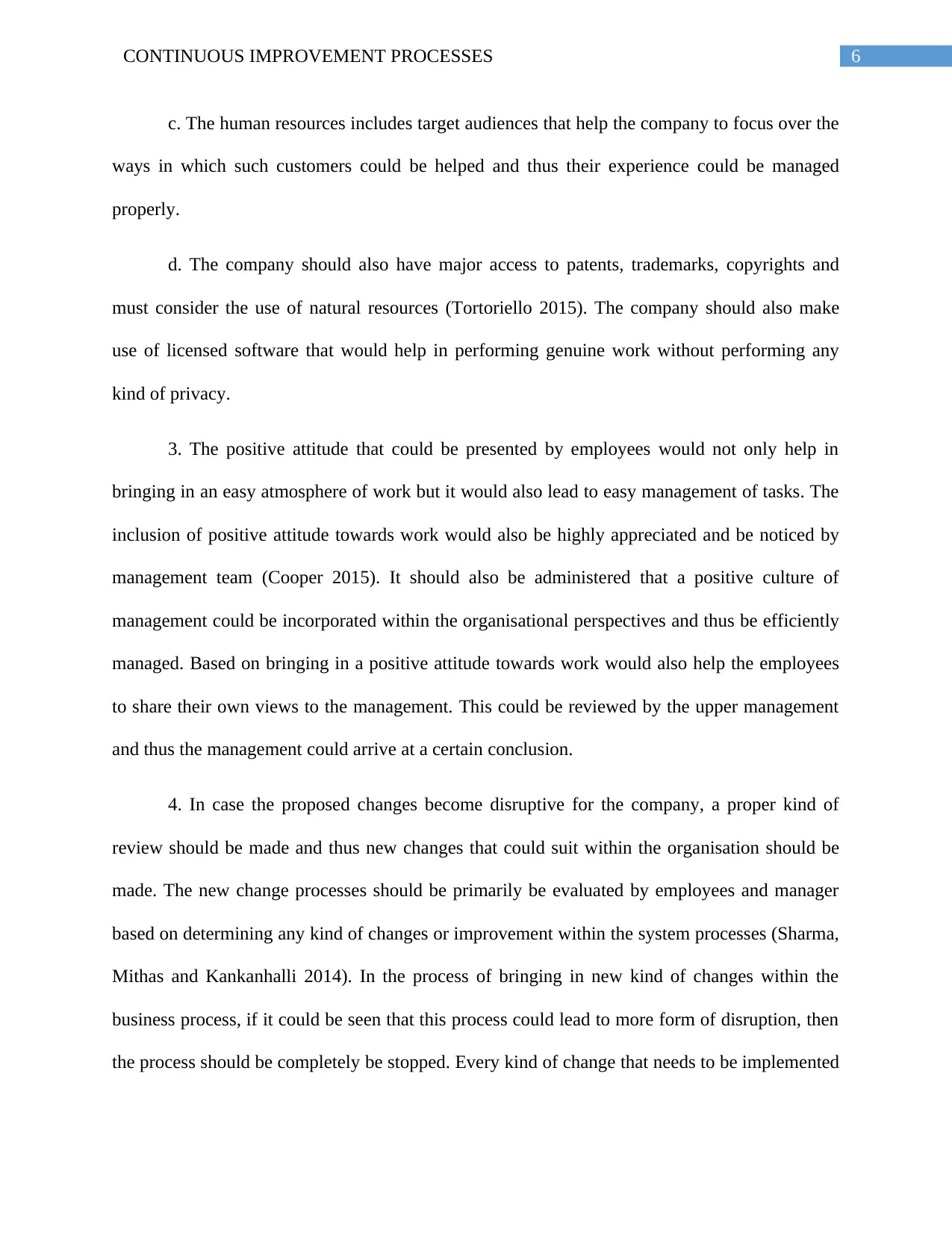
6CONTINUOUS IMPROVEMENT PROCESSES
c. The human resources includes target audiences that help the company to focus over the
ways in which such customers could be helped and thus their experience could be managed
properly.
d. The company should also have major access to patents, trademarks, copyrights and
must consider the use of natural resources (Tortoriello 2015). The company should also make
use of licensed software that would help in performing genuine work without performing any
kind of privacy.
3. The positive attitude that could be presented by employees would not only help in
bringing in an easy atmosphere of work but it would also lead to easy management of tasks. The
inclusion of positive attitude towards work would also be highly appreciated and be noticed by
management team (Cooper 2015). It should also be administered that a positive culture of
management could be incorporated within the organisational perspectives and thus be efficiently
managed. Based on bringing in a positive attitude towards work would also help the employees
to share their own views to the management. This could be reviewed by the upper management
and thus the management could arrive at a certain conclusion.
4. In case the proposed changes become disruptive for the company, a proper kind of
review should be made and thus new changes that could suit within the organisation should be
made. The new change processes should be primarily be evaluated by employees and manager
based on determining any kind of changes or improvement within the system processes (Sharma,
Mithas and Kankanhalli 2014). In the process of bringing in new kind of changes within the
business process, if it could be seen that this process could lead to more form of disruption, then
the process should be completely be stopped. Every kind of change that needs to be implemented
c. The human resources includes target audiences that help the company to focus over the
ways in which such customers could be helped and thus their experience could be managed
properly.
d. The company should also have major access to patents, trademarks, copyrights and
must consider the use of natural resources (Tortoriello 2015). The company should also make
use of licensed software that would help in performing genuine work without performing any
kind of privacy.
3. The positive attitude that could be presented by employees would not only help in
bringing in an easy atmosphere of work but it would also lead to easy management of tasks. The
inclusion of positive attitude towards work would also be highly appreciated and be noticed by
management team (Cooper 2015). It should also be administered that a positive culture of
management could be incorporated within the organisational perspectives and thus be efficiently
managed. Based on bringing in a positive attitude towards work would also help the employees
to share their own views to the management. This could be reviewed by the upper management
and thus the management could arrive at a certain conclusion.
4. In case the proposed changes become disruptive for the company, a proper kind of
review should be made and thus new changes that could suit within the organisation should be
made. The new change processes should be primarily be evaluated by employees and manager
based on determining any kind of changes or improvement within the system processes (Sharma,
Mithas and Kankanhalli 2014). In the process of bringing in new kind of changes within the
business process, if it could be seen that this process could lead to more form of disruption, then
the process should be completely be stopped. Every kind of change that needs to be implemented
Paraphrase This Document
Need a fresh take? Get an instant paraphrase of this document with our AI Paraphraser
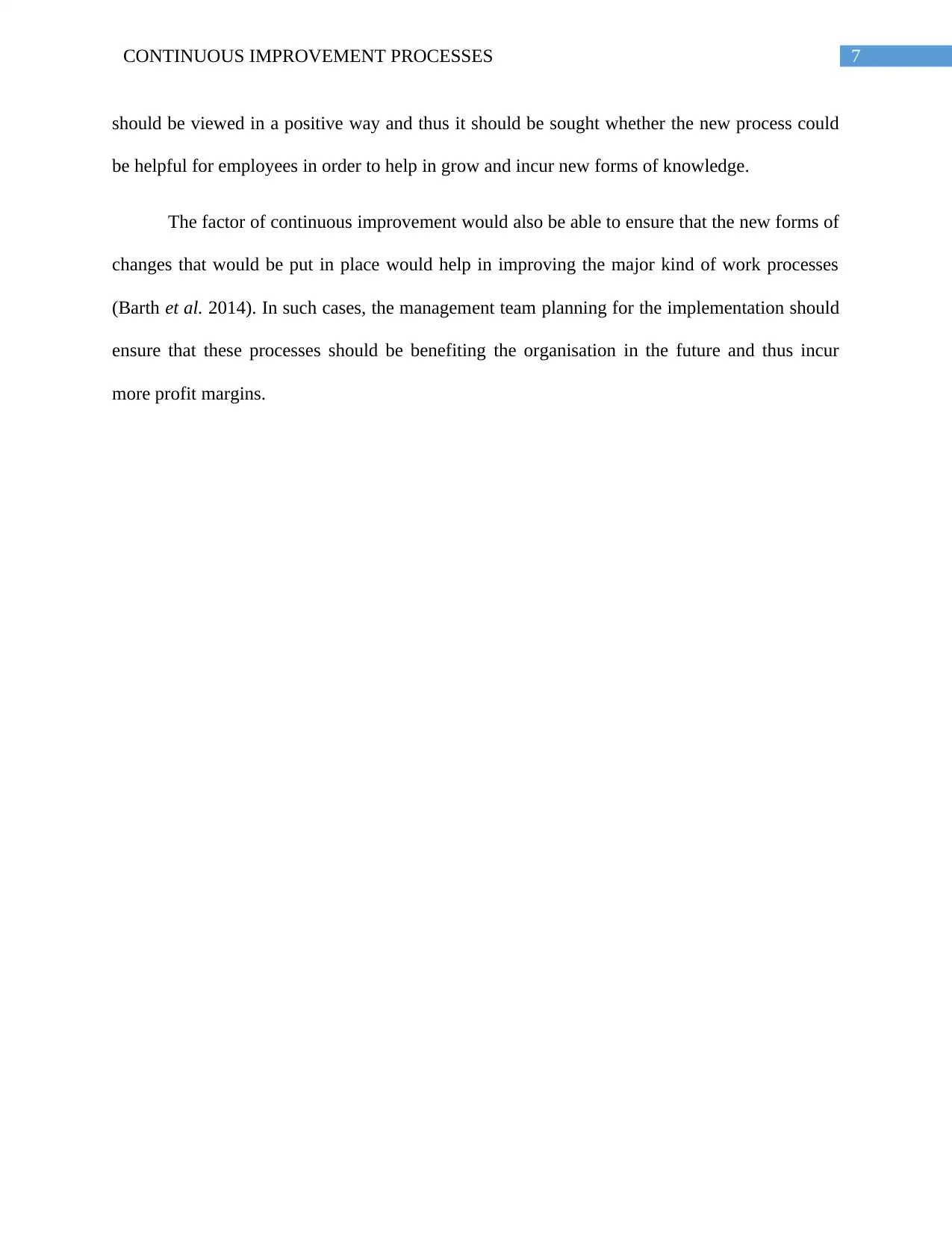
7CONTINUOUS IMPROVEMENT PROCESSES
should be viewed in a positive way and thus it should be sought whether the new process could
be helpful for employees in order to help in grow and incur new forms of knowledge.
The factor of continuous improvement would also be able to ensure that the new forms of
changes that would be put in place would help in improving the major kind of work processes
(Barth et al. 2014). In such cases, the management team planning for the implementation should
ensure that these processes should be benefiting the organisation in the future and thus incur
more profit margins.
should be viewed in a positive way and thus it should be sought whether the new process could
be helpful for employees in order to help in grow and incur new forms of knowledge.
The factor of continuous improvement would also be able to ensure that the new forms of
changes that would be put in place would help in improving the major kind of work processes
(Barth et al. 2014). In such cases, the management team planning for the implementation should
ensure that these processes should be benefiting the organisation in the future and thus incur
more profit margins.
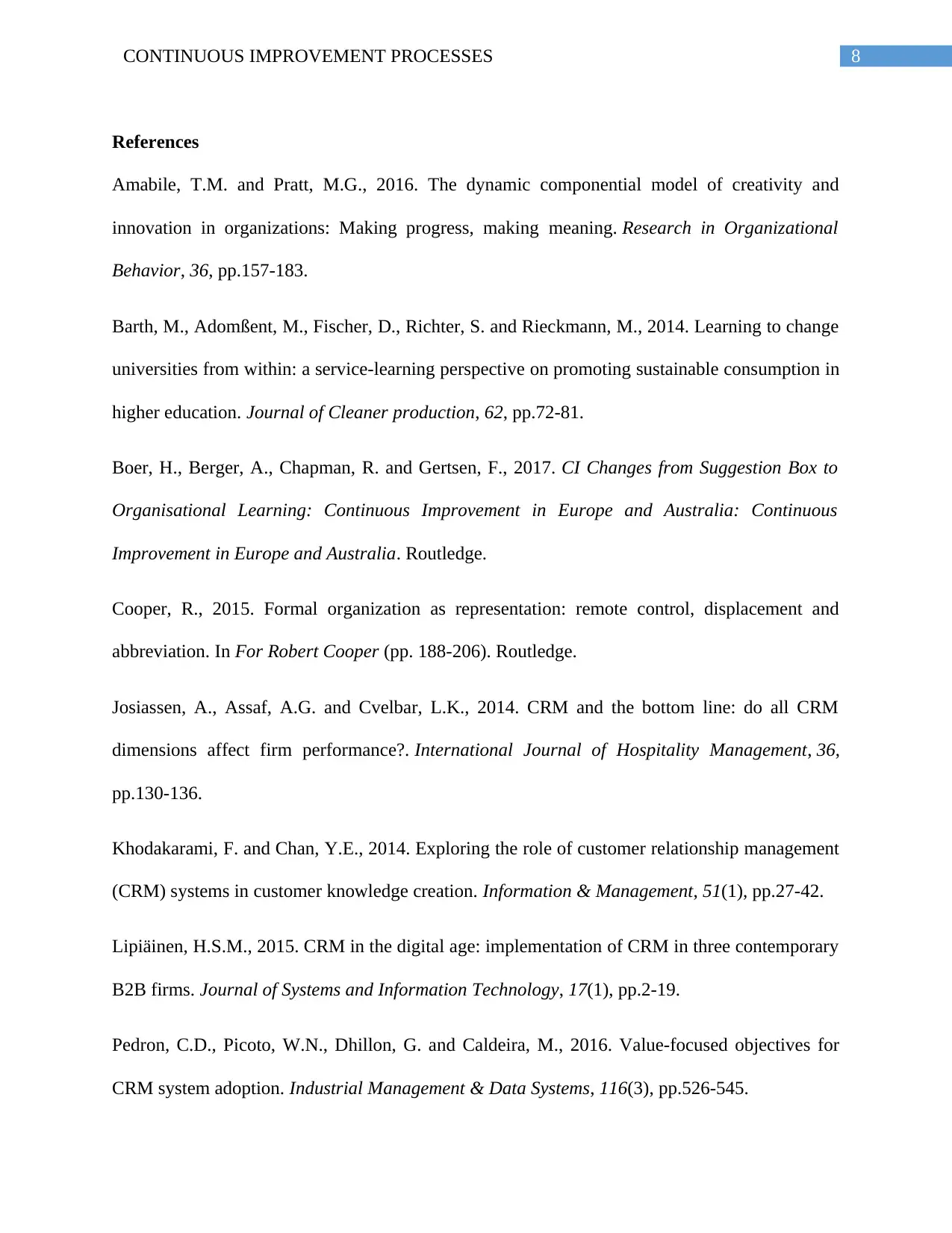
8CONTINUOUS IMPROVEMENT PROCESSES
References
Amabile, T.M. and Pratt, M.G., 2016. The dynamic componential model of creativity and
innovation in organizations: Making progress, making meaning. Research in Organizational
Behavior, 36, pp.157-183.
Barth, M., Adomßent, M., Fischer, D., Richter, S. and Rieckmann, M., 2014. Learning to change
universities from within: a service-learning perspective on promoting sustainable consumption in
higher education. Journal of Cleaner production, 62, pp.72-81.
Boer, H., Berger, A., Chapman, R. and Gertsen, F., 2017. CI Changes from Suggestion Box to
Organisational Learning: Continuous Improvement in Europe and Australia: Continuous
Improvement in Europe and Australia. Routledge.
Cooper, R., 2015. Formal organization as representation: remote control, displacement and
abbreviation. In For Robert Cooper (pp. 188-206). Routledge.
Josiassen, A., Assaf, A.G. and Cvelbar, L.K., 2014. CRM and the bottom line: do all CRM
dimensions affect firm performance?. International Journal of Hospitality Management, 36,
pp.130-136.
Khodakarami, F. and Chan, Y.E., 2014. Exploring the role of customer relationship management
(CRM) systems in customer knowledge creation. Information & Management, 51(1), pp.27-42.
Lipiäinen, H.S.M., 2015. CRM in the digital age: implementation of CRM in three contemporary
B2B firms. Journal of Systems and Information Technology, 17(1), pp.2-19.
Pedron, C.D., Picoto, W.N., Dhillon, G. and Caldeira, M., 2016. Value-focused objectives for
CRM system adoption. Industrial Management & Data Systems, 116(3), pp.526-545.
References
Amabile, T.M. and Pratt, M.G., 2016. The dynamic componential model of creativity and
innovation in organizations: Making progress, making meaning. Research in Organizational
Behavior, 36, pp.157-183.
Barth, M., Adomßent, M., Fischer, D., Richter, S. and Rieckmann, M., 2014. Learning to change
universities from within: a service-learning perspective on promoting sustainable consumption in
higher education. Journal of Cleaner production, 62, pp.72-81.
Boer, H., Berger, A., Chapman, R. and Gertsen, F., 2017. CI Changes from Suggestion Box to
Organisational Learning: Continuous Improvement in Europe and Australia: Continuous
Improvement in Europe and Australia. Routledge.
Cooper, R., 2015. Formal organization as representation: remote control, displacement and
abbreviation. In For Robert Cooper (pp. 188-206). Routledge.
Josiassen, A., Assaf, A.G. and Cvelbar, L.K., 2014. CRM and the bottom line: do all CRM
dimensions affect firm performance?. International Journal of Hospitality Management, 36,
pp.130-136.
Khodakarami, F. and Chan, Y.E., 2014. Exploring the role of customer relationship management
(CRM) systems in customer knowledge creation. Information & Management, 51(1), pp.27-42.
Lipiäinen, H.S.M., 2015. CRM in the digital age: implementation of CRM in three contemporary
B2B firms. Journal of Systems and Information Technology, 17(1), pp.2-19.
Pedron, C.D., Picoto, W.N., Dhillon, G. and Caldeira, M., 2016. Value-focused objectives for
CRM system adoption. Industrial Management & Data Systems, 116(3), pp.526-545.
⊘ This is a preview!⊘
Do you want full access?
Subscribe today to unlock all pages.

Trusted by 1+ million students worldwide
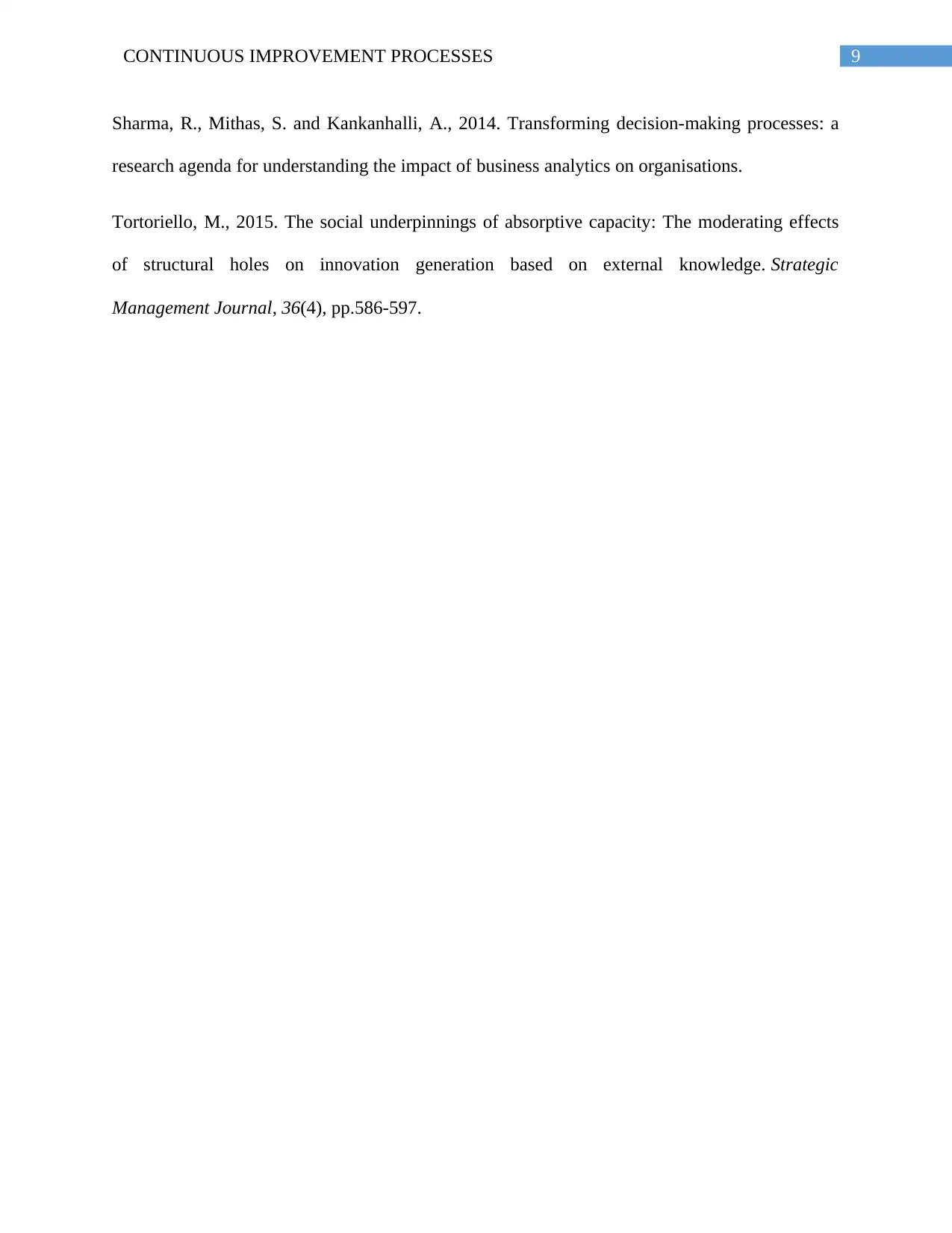
9CONTINUOUS IMPROVEMENT PROCESSES
Sharma, R., Mithas, S. and Kankanhalli, A., 2014. Transforming decision-making processes: a
research agenda for understanding the impact of business analytics on organisations.
Tortoriello, M., 2015. The social underpinnings of absorptive capacity: The moderating effects
of structural holes on innovation generation based on external knowledge. Strategic
Management Journal, 36(4), pp.586-597.
Sharma, R., Mithas, S. and Kankanhalli, A., 2014. Transforming decision-making processes: a
research agenda for understanding the impact of business analytics on organisations.
Tortoriello, M., 2015. The social underpinnings of absorptive capacity: The moderating effects
of structural holes on innovation generation based on external knowledge. Strategic
Management Journal, 36(4), pp.586-597.
1 out of 10
Related Documents
Your All-in-One AI-Powered Toolkit for Academic Success.
+13062052269
info@desklib.com
Available 24*7 on WhatsApp / Email
![[object Object]](/_next/static/media/star-bottom.7253800d.svg)
Unlock your academic potential
Copyright © 2020–2025 A2Z Services. All Rights Reserved. Developed and managed by ZUCOL.




